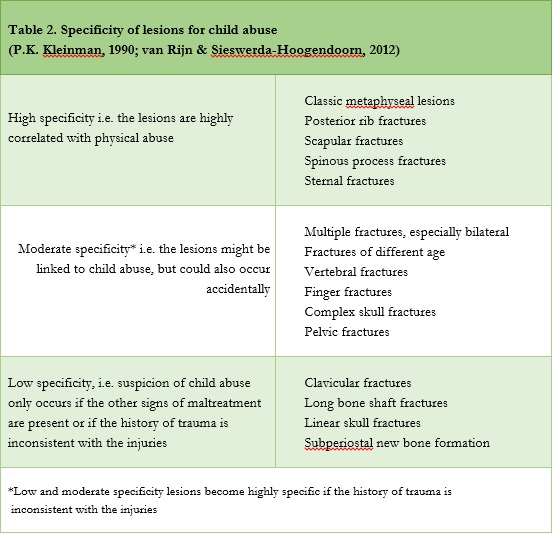Guidelines for skeletal surveys in suspected child abuse
DOI:
https://doi.org/10.7577/radopen.1190Keywords:
Battered child syndrome, Consensus development, Exposure technique, Fracture, Image quality, Non-accidental injury, Lead marker, Patient handling, Pediatric radiography, Radiography, Side marker, Skeletal surveyAbstract
Introduction
Child abuse imaging differs from general musculoskeletal imaging in that there is exceptional necessity for high quality images. The images are directly involved in legal processes and the child and the family faces major consequences if imaging is sub-optimal. The consequences of misdiagnosis are serious. Should head trauma or fractures be overlooked, or if the radiological diagnosis is uncertain, abused children may be sent home with violent parents or caregivers. Conversely, where no abuse has taken place, but the certainty of the diagnosis is questionable, the unnecessary hospitalization of an innocent family may result.
In Southern Denmark approximately 15-20 children per year are examined. The examinations are performed in four different radiology departments throughout the region. Until the autumn of 2012, a variety of imaging protocols and techniques were used in pediatric skeletal surveys. This led to difficulties, because some cases are subject to second opinion report. In many cases, supplemental images or a complete reexamination of the child was required in order to facilitate a second opinion, resulting in unnecessary exposure.
Methods
An initial consensus meeting with 20 participants was arranged in 2012. Pediatric radiologists, managers and radiographers with special competencies in pediatric radiology attended. Research evidence, cases and clinical experience was discussed.
A follow-up meeting was arranged in 2013 with similar participants. This second meeting focused mainly on follow-up skeletal surveys in children <2 years of age
Results
The first meeting resulted in the agreement on which projections to acquire, image quality criteria, how to cooperate with the parents, radiologic evaluation criteria and the role of the radiographer in imaging the abused child. The second meeting resulted in consensus on the necessary projections required for follow-up skeletal surveys.
Common protocols for child abuse imaging have been established and fully implemented in the Region of Southern Denmark. Annual meetings have also been established where legal aspects, best practice and best evidence in imaging and cooperation with pediatric departments is discussed.
References
Dubbins, P. P., J; Johnson, K; Maguire, S; Wall, LM; Jaspan, T; Hobbs, C; Stoodley, N; Chapman, S; Kemp, A. (2008). Standards for Radiological Investigations of Suspected Non-accidential Injury: Royal College of Radiologists.
Erfurt, C., Hahn, G., Roesner, D., & Schmidt, U. (2011). Pediatric radiological diagnostic procedures in cases of suspected child abuse. Forensic Sci Med Pathol, 7(1), 65-74. doi: 10.1007/s12024-010-9148-y
http://dx.doi.org/10.1007/s12024-010-9148-y
Faerber, E. N., Fordham, L. A., Singh, S. P., Kleinman, P. K., & Perez-Rossello, J. M. (2011). ACR-SPR Practice Guideline for Skeletal Surveys in Children: American College of Radiology.
Geller, E. (2011). Imaging in Child Abuse. Medscape Reference. Retrieved from Medscape website: http://emedicine.medscape.com/article/407144-overview
Harper, N. S., Eddleman, S., & Lindberg, D. M. (2013). The utility of follow-up skeletal surveys in child abuse. Pediatrics, 131(3), e672-678. doi: 10.1542/peds.2012-2608
http://dx.doi.org/10.1542/peds.2012-2608
Kemp, A. M. (2011). Abusive head trauma: recognition and the essential investigation. Archives of disease in childhood - Education & practice edition, 96(6), 202-208. doi: 10.1136/adc.2009.170449
http://dx.doi.org/10.1136/adc.2009.170449
Kleinman, P. K. (1990). Diagnostic imaging in infant abuse. AJR Am J Roentgenol, 155(4), 703-712.
http://dx.doi.org/10.2214/ajr.155.4.2119097
PMid:2119097
Kleinman, P. K. (1998). Diagnostic imaging of child abuse (Vol. 2. ed.). St. Louis, Mo.: Mosby.
Michelsen, N., Hansen, B. V. L., Myhre, A. K., & Johannessen, T. (2010). Lægehåndbogen - Børnemishandling. Lægehåndbogen. Retrieved 4/12 2012, from https://www.sundhed.dk/sundhedsfaglig/laegehaandbogen/paediatri/tilstande-og-sygdomme/socialpaediatri/boernemishandling/
Oehmichen, M., Auer, R. N., & König, H. G. (2006). Forensic Neuropathology and Associated Neurology. Berlin, Heidelberg: Springer-Verlag Berlin Heidelberg.
Oral, R., Yagmur, F., Nashelsky, M., Turkmen, M., & Kirby, P. (2008). Fatal abusive head trauma cases: consequence of medical staff missing milder forms of physical abuse. Pediatr Emerg Care, 24(12), 816-821. doi: 10.1097/PEC.0b013e31818e9f5d
http://dx.doi.org/10.1097/PEC.0b013e31818e9f5d
Scavarda, D., Gabaudan, C., Ughetto, F., Lamy, F., Imada, V., Lena, G., & Paut, O. (2010). Initial predictive factors of outcome in severe non-accidental head trauma in children. Child's Nervous System, 26(11), 1555-1561. doi: 10.1007/s00381-010-1150-x
http://dx.doi.org/10.1007/s00381-010-1150-x
Sieswerda-Hoogendoorn, T., Boos, S., Spivack, B., Bilo, R. A., & van Rijn, R. R. (2012). Educational paper: Abusive Head Trauma part I. Clinical aspects. Eur J Pediatr, 171(3), 415-423. doi: 10.1007/s00431-011-1598-z
http://dx.doi.org/10.1007/s00431-011-1598-z
Southall, D. P., Plunkett, M. C., Banks, M. W., Falkov, A. F., & Samuels, M. P. (1997). Covert video recordings of life-threatening child abuse: lessons for child protection. Pediatrics, 100(5), 735-760.
http://dx.doi.org/10.1542/peds.100.5.735
PMid:9346973
van Rijn, R. R., & Sieswerda-Hoogendoorn, T. (2012). Educational paper: imaging child abuse: the bare bones. Eur J Pediatr, 171(2), 215-224. doi: 10.1007/s00431-011-1499-1
http://dx.doi.org/10.1007/s00431-011-1499-1
Vitale, M. A., Squires, J., Zuckerbraun, N. S., & Berger, R. P. (2010). Evaluation of the siblings of physically abused children: a comparison of child protective services caseworkers and child abuse physicians. Child Maltreat, 15(2), 144-151. doi: 10.1177/1077559509360250
http://dx.doi.org/10.1177/1077559509360250

Downloads
Published
How to Cite
Issue
Section
License
Authors who publish with this journal agree to the following terms:- Authors retain copyright and grant the journal right of first publication, with the work after publication simultaneously licensed under a Creative Commons Attribution License that allows others to share the work with an acknowledgement of the work's authorship and initial publication in this journal.
- Authors are able to enter into separate, additional contractual arrangements for the non-exclusive distribution of the journal's published version of the work (e.g., post it to an institutional repository or publish it in a book), with an acknowledgement of its initial publication in this journal.
- Authors are permitted and encouraged to post their work online (e.g., in institutional repositories or on their website) prior to and during the submission process, as it can lead to productive exchanges, as well as earlier and greater citation of published work (See The Effect of Open Access).



